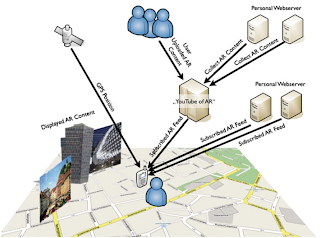Today, I looked at a research paper from 2011 entitled Augmented Reality 2.0. The team behind this paper took a fresh look at AR by comparing it to another popular buzz word - Web 2.0. As they described it, the move to Web 2.0 involved a shift toward massive, simultaneously connected, and user-driven content. In addition, there was a paradigm shift to mask the differences between different sets of data - that is, local data should be indistinguishable from roaming data, and different content sources should be able to be mashed together into new, dynamically generated content. In the researchers' opinions, this should be the goal of augmented reality as well (see figure).
(image from the paper)
The researchers then went into the components that they thought were most important when developing AR content-generators. The first, application data, would essentially be a transference of the way Web 2.0 handles its data - through the AJAX model of asynchronous, multi-threaded Javascript execution. The next component, real-world representation, is being solved right now through a variety of methods, including planar surfaces, geo-location data, and even pure camera-based data. The third (and biggest) challenge is the actual development of client-side AR applications. The team identified several authoring tools that could be used, including some for non-programmers (see figure). It's worth noting that the biggest challenge here is still the development of mobile AR applications by non-programmers, but the researchers believed that the wide array of easy-to-understand Python scripts could be combined to make it work.
(image from the paper)
After describing a few case studies that were beginning to make use of these components, the paper concluded with some brief miscellaneous thoughts. First, they recognized a need for more research in the area of outdoor localization, believing GPS to be too inaccurate to fully realize AR 2.0 and recommending computer vision techniques now that mobile phones have become much more powerful. Next, they looked at potential development areas, seeing that potential in just about every area, from personal exploration to urban planning to education. Finally, they briefly discussed the need for better user evaluation techniques, stating that current methods are too small and too qualitative.
Overall, I feel like this article gave me more confidence in the importance of what my project group is working on. Group Graffiti seeks to help answer many of the concerns of "AR 1.0", and with applications like ours continually being developed, AR 2.0 could be well on its way.
Thanks and gig 'em!
Billinghurst, Mark; Langlotz, Tobias; Schmalstieg, Dieter; "Augmented Reality 2.0," Virtual Realities, pp.13-37. 2011.
doi: 10.1007/978-3-211-99178-7_2
Url: http://dx.doi.org/10.1007/978-3-211-99178-7_2


No comments:
Post a Comment